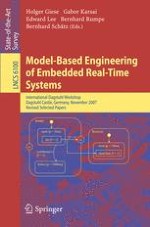Thetopicof“Model-BasedEngineeringofReal-TimeEmbeddedSystems”brings together a challenging problem domain (real-time embedded systems) and a - lution domain (model-based engineering). It is also at the forefrontof integrated software and systems engineering, as software in this problem domain is an essential tool for system implementation and integration. Today, real-time - bedded software plays a crucial role in most advanced technical systems such as airplanes, mobile phones, and cars, and has become the main driver and - cilitator for innovation. Development, evolution, veri?cation, con?guration, and maintenance of embedded and distributed software nowadays are often serious challenges as drastic increases in complexity can be observed in practice. Model-based engineering in general, and model-based software development in particular, advocates the notion of using models throughout the development and life-cycle of an engineered system. Model-based software engineering re- forces this notion by promoting models not only as the tool of abstraction, but also as the tool for veri?cation, implementation, testing, and maintenance. The application of such model-based engineering techniques to embedded real-time systems appears to be a good candidate to tackle some of the problems arising in the problem domain.
